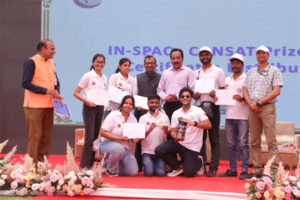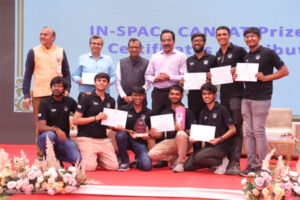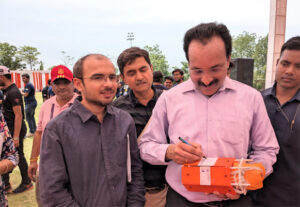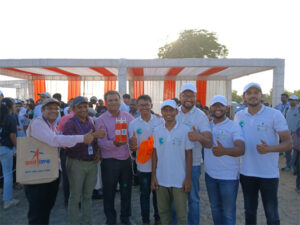- IN-SPACe CANSAT India Student Competition 2024 is a resounding success in fostering future Space Innovators
- Team Vihanga from Lovely Professional University emerged triumphant among 28 Teams from across the country to win the competition
- IITRAM team Astropeep selected for Final launch
NE SCIENCE & TECH BUREAU
AHMEDABAD, APRIL 17
The Indian Space Research Organisation (ISRO) Chairman, Secretary- Department of Space (DoS), and President- Astronautical Society of India (ASI), S Somanath on Wednesday said ISRO will continue its Chandrayaan series of lunar probes until an astronaut from the country lands on the Moon.

He was speaking as the Chief Guest of the IN-SPACe CANSAT India Student Competition 2024 here on Wednesday. Speaking to the media, Somanath said, “Chandrayaan 3 has done very well. Data has been collected and scientific publication has just started. Now, we want to continue the Chandrayaan series till an Indian lands on the Moon. Before that, we have to master many technologies, such as going there and coming back. That we are trying to do in the next mission,” he told reporters on the sidelines of an event.

About India’s first-ever human space flight mission, Gaganyaan, Somanath said ISRO will carry out an uncrewed mission, a test vehicle flight mission and an airdrop test this year.

“The airdrop test will happen on April 24. Then two more uncrewed missions will happen next year and then the manned mission, if everything goes well, by the end of next year,” the ISRO chairman said.
He said, “The CANSAT competition is a testament to India’s commitment to fostering a culture of innovation and scientific exploration. By motivating students to opportunity to gain hands-on experience through a competitive platform and mentorship, we are empowering them to become the next generation of space scientists, engineers, and entrepreneurs.”
Dr. Pawan Goenka, Chairman, IN-SPACe was enthusiastic about the event’s success and said, “The response to the IN-SPACe CANSAT Competition has exceeded our expectations. Witnessing the dedication, creativity, and technical prowess of these young minds has been truly inspiring. We could see the spark of passion for space in the participants and I am confident that they will be the driving force behind India’s future space endeavours. This reassures our commitment to continue to nurture inculcate a space science and technology temperament among the student community.”
Dr. Vinod Kumar, Director-Promotion Directorate, IN-SPACe and Executive Secretary, Astronautical Society of India (ASI) highlight the significance of the event, “We are happy that the IN-SPACe CANSAT Competition has been successful in showcasing the immense potential of such initiatives to create India’s future space force from the student community. By providing a platform for them to demonstrate their skills, the event has sown the seeds of curiosity and ambition that will propel them towards successful careers in the space industry in the near future.”
The IN-SPACe CANSAT India Student Competition, a collaborative effort between the Indian National Space Promotion and Authorization Centre (IN-SPACe) and the Astronautical Society of India (ASI), concluded on Wednesday after two days of intense competition. The event saw 28 teams from across the country come together in a thrilling display of innovation and ingenuity as they competed in designing, developing, and launching their own CAN-sized satellites.
The competition culminated in a prize and certificate distribution ceremony where teams were recognized for their achievements in various categories, including best overall design, technical innovation, and mission accomplishment. Team Vihanga from Lovely Professional University won the first prize while Team Dyaus from the Institute of Technology, Nirma University won the second prize and Team M.A.T.R.I.X from the Bharath Institute of Higher Education and Research got the third prize. The other winners included Team VINIDRA from MKSSS’ Cummins College of Engineering for Women, which won the prize for Best Team Work and Team NAMBI VJ from the Vidya Jyothi Institute of Technology, which won the prize for Best Design.
The competition provided a unique platform for students to gain practical experience in space science and technology. Teams successfully rose up to the challenge of launching their CANSATs to an altitude of 800 meters using drones. This hands-on challenge not only tested their technical skills but also encouraged a deep understanding of the practical aspects of satellite technology as the participants had to consider various aspects such as payload design, telemetry systems, and recovery mechanisms. The event fostered teamwork, problem-solving skills, and a passion for space exploration among the participants.
The team Astropeep from IITRAM, under the supervision of Dr. Abhishek Rawat, successfully met stringent criteria by leveraging in-house 3D printing technology available at CoE – Drone Technology to expedite development while reducing the cost-NE photo
IITRAM team Astropeep selected for Final launch
IITRAM Team – Astropeep, comprising 11 students from the Departments of Mechanical Engineering and Electrical and Computer Science Engineering has earned the distinction of being selected for the final launch in the prestigious first of its kind CANSAT India student competition held across India. On April 15, 2024, the team executed a flawless satellite launch using the NAL-CSIR drone and subsequently executed a successful recovery operation.
The CANSAT India student competition challenged students to design, develop, and demonstrate a working model satellite weighing less than 700 grams. Additionally, it required the inclusion of a mechanical gyro-control system capable of managing the descent of the CANSAT, with its parachute activating at a height of approximately 500 meters during descent.
The team Astropeep from IITRAM, under the supervision of Dr. Abhishek Rawat, successfully met these criteria by leveraging in-house 3D printing technology available at CoE – Drone Technology to expedite development while reducing the cost. Equipped with high-resolution Accelerometer, Gyro, Temperature, Altitude, and GPS sensors, the CANSAT transmitted all these sensory data in real-time by telemetry to the ground station. Despite encountering several obstacles from mechanical design to coding, the Team persevered to achieve its goals.










